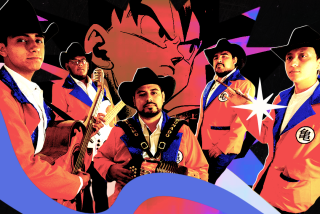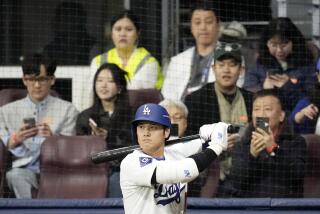In Brazil, land of beaches and samba, a sumo wrestling academy thrives

The sensei’s voice echoes off the high tin roof of the gym as his 18 students stretch, squat, bend and lift their limbs.
“Ichi!” One.
“Ni!” Two.
“San!” Three.
The counting is in Japanese, but few here look like gargantuan sumo wrestlers. Many are thin and sinewy, sweat beading on their tanned skin. Some men have goatees, others full beards. Very few are of Japanese descent. They wear boxer briefs or bike shorts under their mawashis, the sumo belts they help one another don before practice starts.
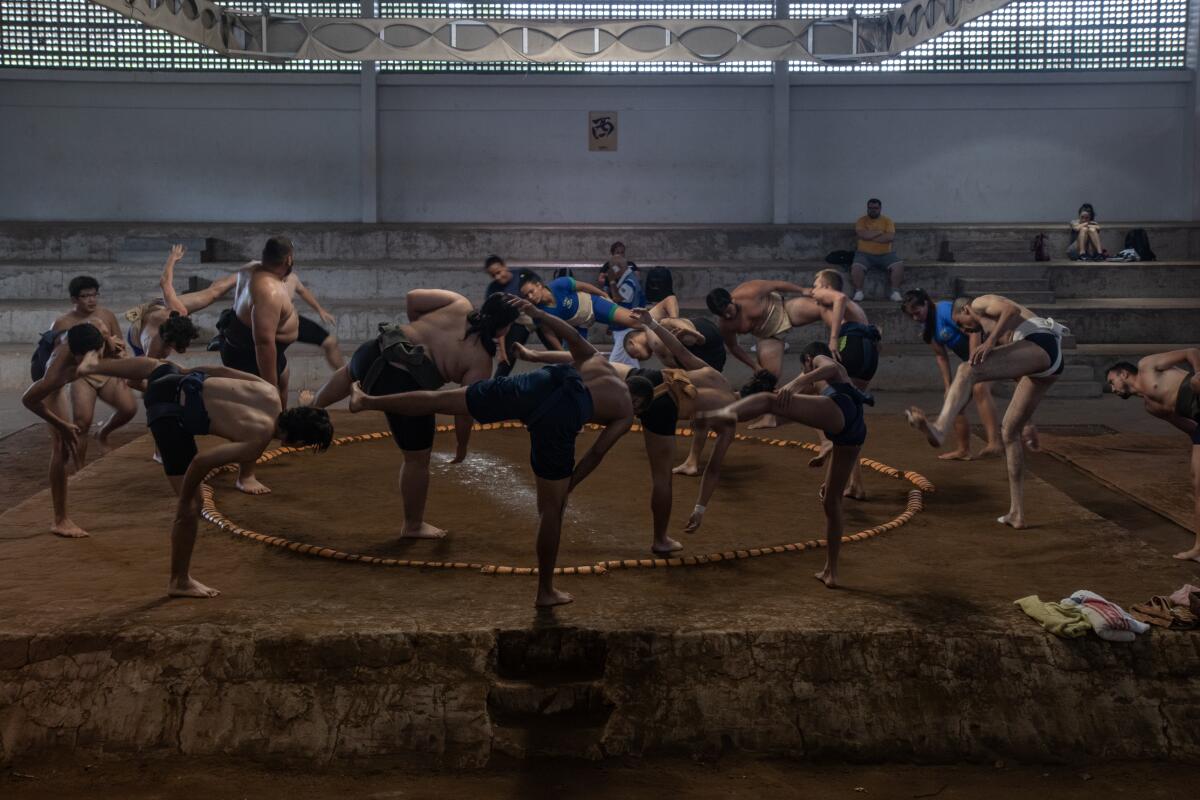
There even are a few women here — something unheard of in Japan. They wear specially made blue bodysuits under their belts, a Brazilian flag stitched over their hearts.
Standing in the center of the group is Rui Junior who, at 342 pounds, is easily the biggest here. He is also the most agile.
His legs don’t quiver like those of some of the others. He’s been doing this for 13 years, ever since he was spotted helping his uncle, who owns a tent rental business, at a sumo event in his hometown of Londrina.
Even at 12 he was a big kid, but back then he knew nothing about sumo. The only Japanese culture he had been exposed to was the anime series he sometimes watched on TV. Now, at 25, Junior has 14 Brazilian championships under his belt and has gone four times to the Worlds, taking third place twice.
This year, he’s hoping to go even further.
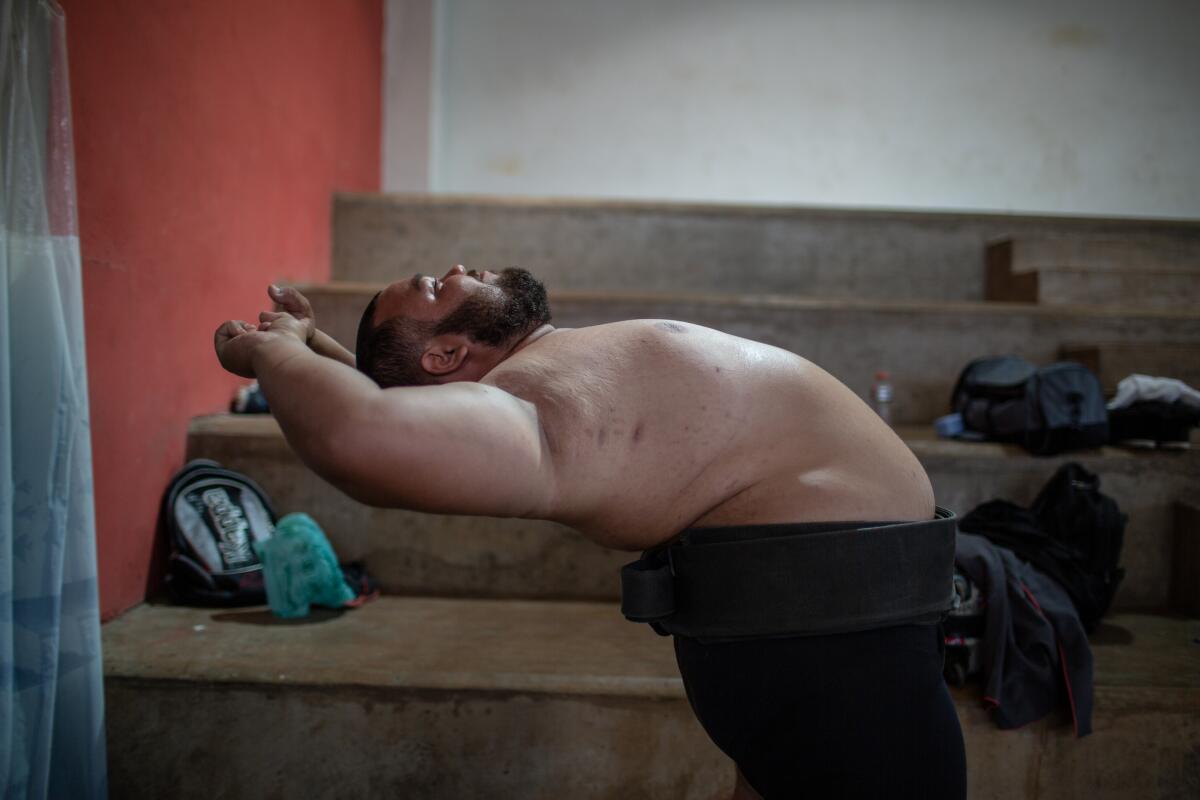
That is why he can be found here at Sao Paulo’s Mie Nishi gym, which bills itself as the only gym outside Japan solely dedicated to sumo. The gym is a vibrant, and sweaty, reminder that Brazil has the largest Japanese population outside the homeland — about 1.5 million — and that Japanese culture has become an ever-present part of Brazilian life.
The population took root when Japanese immigrants began arriving in 1908, a solution to a labor shortage on Sao Paulo coffee plantations after Brazil finally abolished slavery in 1888. Another wave set out for Brazil after World War II, giving a significant boost the population of nikkeis, as they are known.
The reach of Japanese culture into Brazilian life can produce some surprising perceptions, at least to non-Brazilians. It’s not unusual, for example, to find Brazilians who associate baseball more with Japan than the United States.
Column One
Column One is a showcase for compelling storytelling from Los Angeles Times.
In Sao Paulo’s Liberdade neighborhood, known for the red lanterns that hang above its streets and for being home to several Asian diasporas, there seem to be Japanese restaurants — both sushi and non — on every corner, from the most traditional to the unconventional. But the quirkiest of Japanese fusion can be found outside the neighborhood, in restaurants that dot the entire country, offering sushi rolls with passion fruit and goiabada (a guava paste dessert) and pizza covered in sushi.
Anime and tokusatsu — live-action TV shows such as “Jaspion” and “Jiraiya” — were what every Brazilian kid ran home to watch after school in the 1980s and ’90s. There’s no rush to catch the beginning of such shows anymore thanks to streaming, but the Japanese programs continue to be popular among Brazilian kids and adults alike, as are manga for those who prefer comic books and graphic novels.
Sumo used to be a sport almost exclusively practiced by nikkeis, but as Japanese culture became more popular among non-Japanese Brazilians, sumo shifted closer to the mainstream, thanks in particular to a manga-turned-anime series called “Hinomaru Sumo.” Some of the newer athletes at today’s four-hour training session were drawn to the sport because of the sumo-inspired graphic novel.

Others, like Junior, fell for it long before the series started making waves. The sensei leading the training session at Mie Nishi is Kioshi Shimazaki, one of the few nikkeis at the gym on a Sunday morning.
This class is fuller than usual. It’s the last time they’ll train before they compete. The megacity is hosting both the local Paulista Championships as well as tryouts for the Brazilian national team, set to participate in the Sumo World Championships this October in Japan.
These championships abide by far looser regulations than those governing the tradition-bound world of sumo in Japan. In fact, they are considered amateur competitions. Athletes can be of any age, gender and size. They’re filtered into weight categories, similar to those used in boxing.
Junior doesn’t have to weigh in to know his category. Men’s heavyweights are anything above 253 pounds. But weight, he says, isn’t what matters. It’s his preparedness, his agility and his skill that will take him far. His focus now is solely on Shimazaki’s instructions.
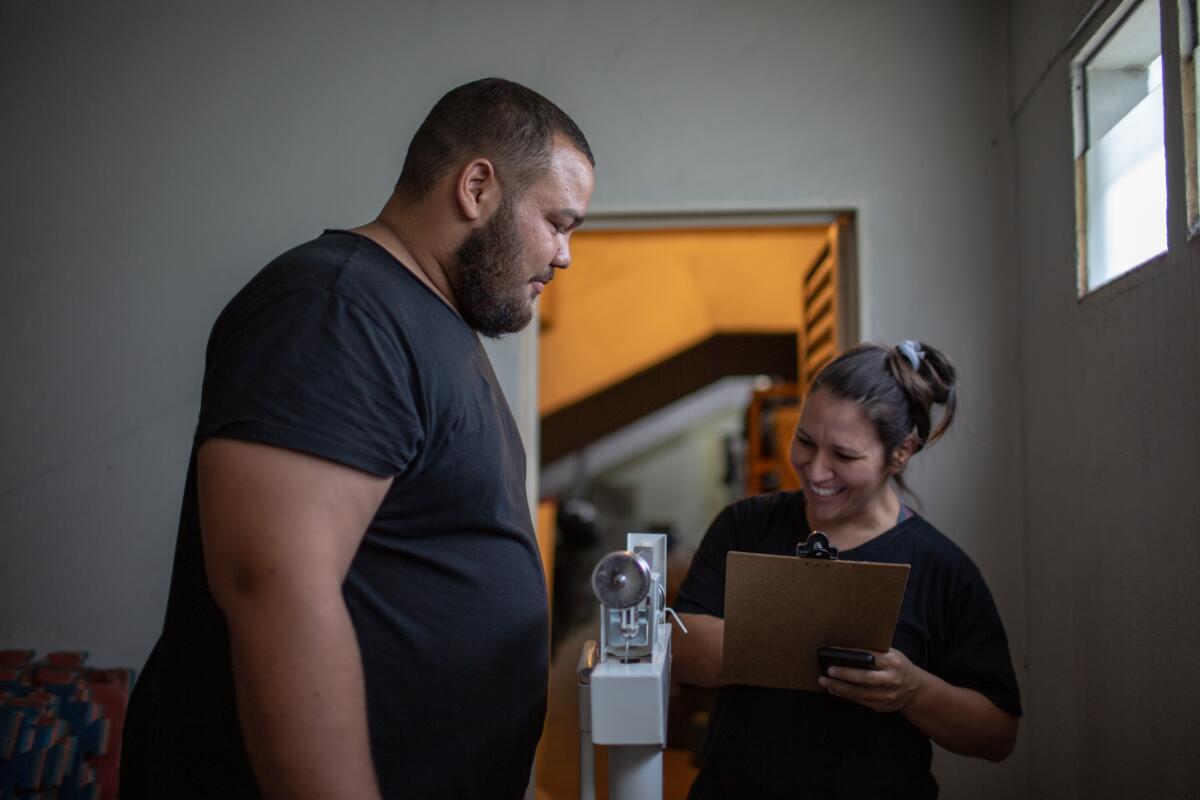
Bare feet planted firmly in the dirt of the dohyo — a raised platform where bouts take place with a ring, or tawara, at its center — the athletes try to follow Shimazaki’s slow and steady instructions.
First, they turn their toes out and bend at the knee until their thighs are parallel with the ground. With their palms resting on their knees, they follow Shimazaki as he slowly stands and lifts his left leg into an arc, his left hand sliding up to his waist as it bends to the side. His eyes remain fixed on the dirt under his right foot as his torso becomes perfectly horizontal.
They repeat the movement — a fundamental sumo exercise called shiko — on the right side. Shimazaki, who has been a rikishi, or sumo wrestler, for 42 years, watches closely, his brow furrowed. Junior performs the moves precisely. The others, not so much.
“Stop,” Shimazaki says in Portuguese. The only Japanese used during training is for numbers and technical terms. Most wouldn’t understand anything else. He explains the stretch to them again, step by step. It can’t be rushed. The students nod and start over, this time more slowly, as their sensei slowly takes up the count again.
“Ichi! Ni! San!”
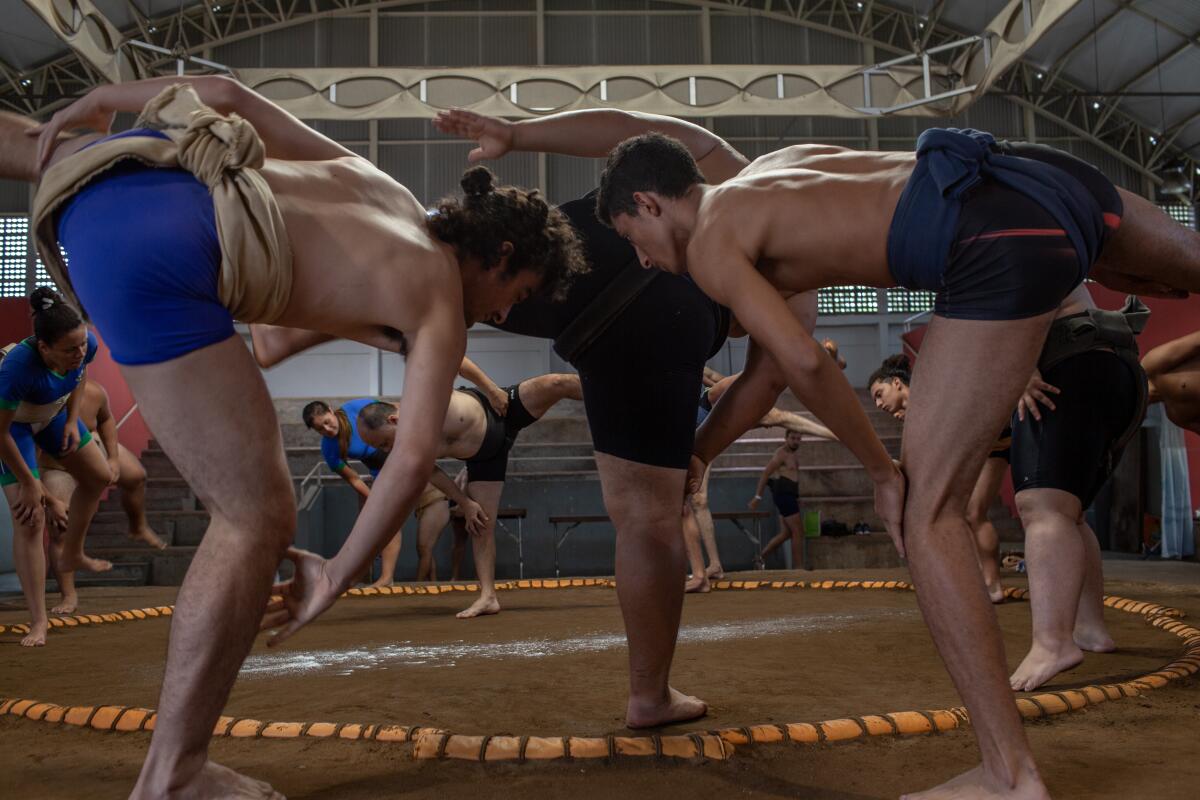
After Sunday’s training session, Junior will head back to Londrina. His state’s sumo federation went under a few years ago, and ever since he’s been making the eight-hour bus trip two weekends a month to train in Sao Paulo. He has a degree in physical education and hopes to one day teach sumo and martial arts in schools, but hasn’t landed a teaching job yet.
For now, Junior still works at his uncle’s tent rental shop. He’s managed to save up enough money to fly to Sao Paulo for the upcoming competitions. He’s a big guy and the bus ride can be uncomfortable. He wants to make sure he gets a good night’s sleep before he fights for his place on the national team.
The following Saturday morning, he wakes up at the gym. Its walls are bare except for two plaques on opposite sides with the Japanese characters for Mie and Nishi scrawled on them. They mean “look west,” a nod to the perspective of the Japanese immigrants who started over in Brazil.
Several friends and teammates had invited him to stay at their homes, but he always sleeps on a thin mattress on the floor of Mie Nishi before competition days. It gives him good luck, he says, and reminds him of when he used to make the trip to the big city with his old team from Londrina.
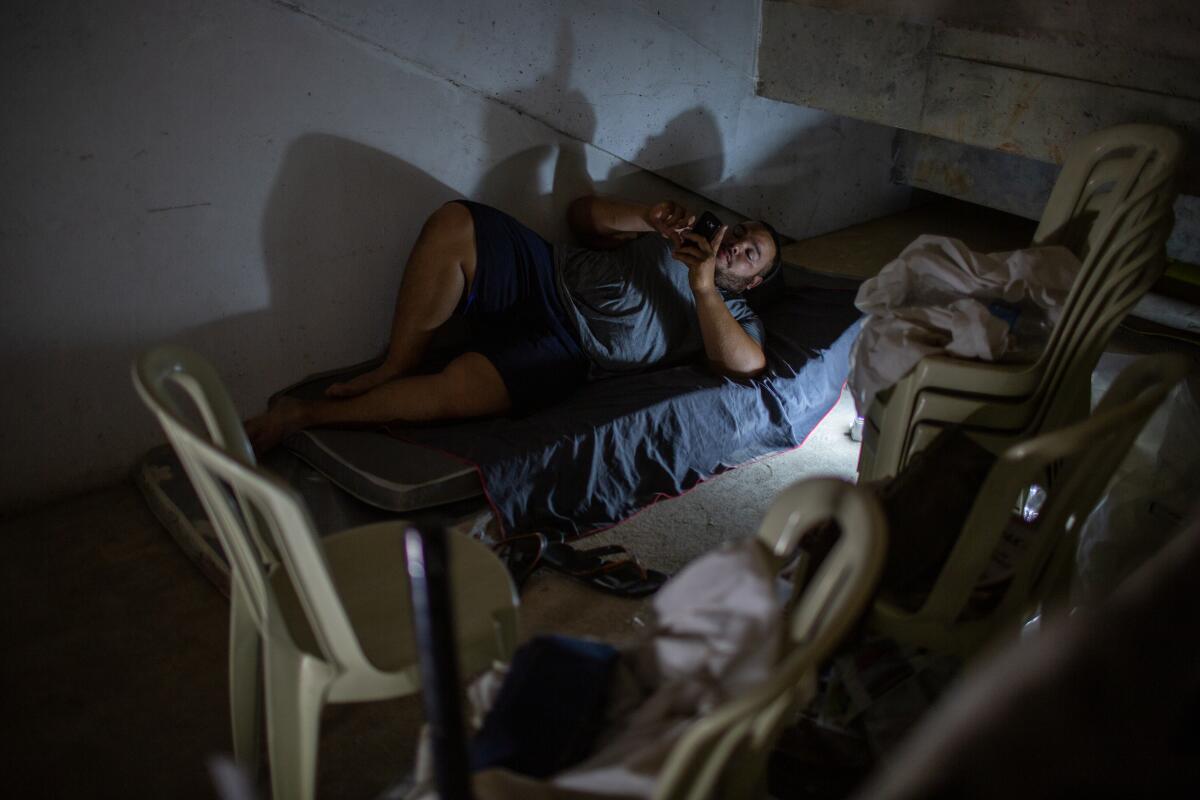
There were supposed to be six competitors in his category, but four were unable to make the long trip to Sao Paulo. There are no opportunities for sponsorship in Brazilian sumo, so athletes pay for everything out of pocket. Junior missed last year’s Worlds because he couldn’t afford the trip to Taiwan.
He doesn’t eat breakfast when he competes and sometimes skips lunch, too, if the matches run long.
But today is expected to be short. The average bout lasts five seconds and only the men are competing. Few women signed up, so they’ll go straight through to the Worlds. Junior is the favorite to win and will only have to compete against one other rikishi in a best-out-of-three.
There are two white lines painted in the center of the tawara, marking where each rikishi will be positioned at the start of a bout. A brown wooden basket of salt sits at the edge of the dohyo. Rikishis often toss a handful onto the dirt floor before competing, a tradition meant to purify the air.
Shimazaki helps Junior wrap his black mawashi as the lightweight rikishis get ready to compete. Traditional mawashis are white, but the comparisons to diapers have made black or navy versions more popular. Once it’s on, Junior pulls a black T-shirt over his head, drapes a pink towel over his shoulders and slaps his thighs to keep his muscles warm.
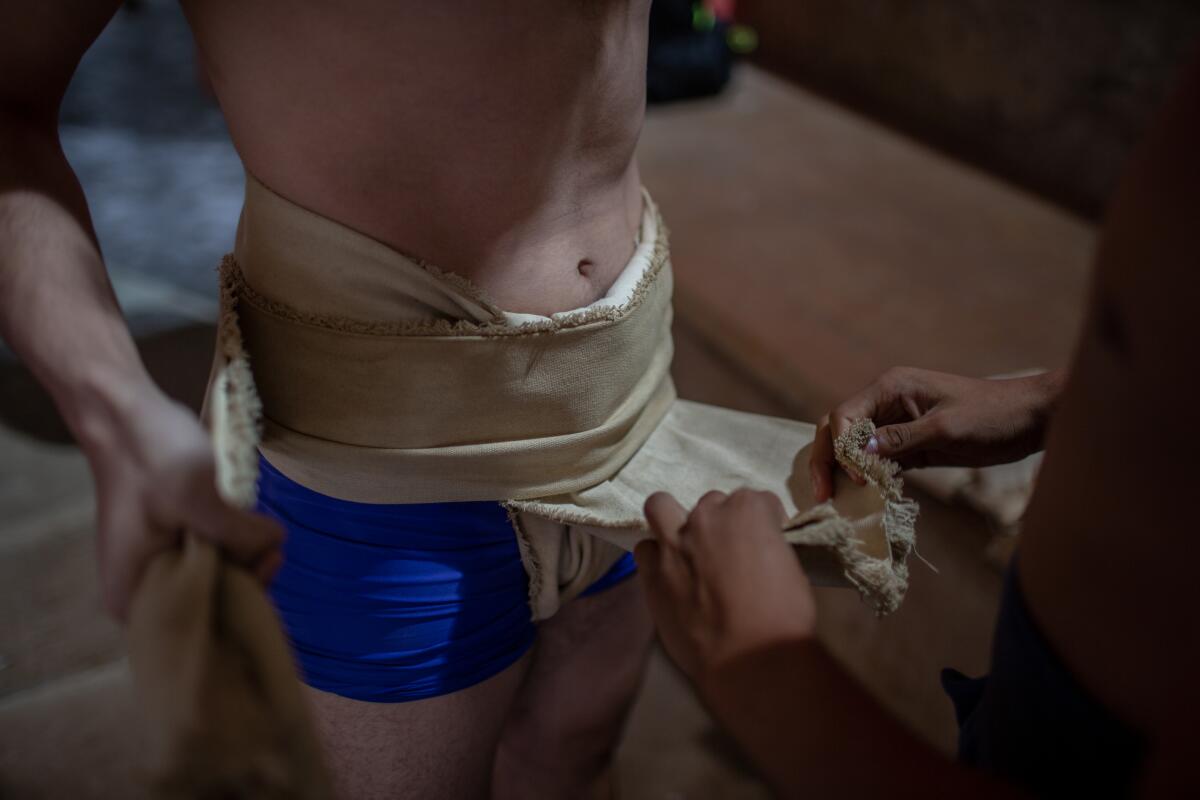
An hour goes by as the lightweight and middleweight rikishis attempt to push their opponents out of the tawara or to the ground. The referee — a visiting sensei from Japan who has helped the Sao Paulo team train — isn’t wearing the elaborate gowns of traditional sumo referees. He looks like a typical boxing judge, all in white, save for a black bow tie.
He starts each bout with his hands outstretched, dropping them toward the ground as a signal for the rikishis to lunge. He’s been in Brazil long enough to know some Portuguese, but actions — hand motions, nods, pats on the back — are often easier than words.
Gasps and cheers from the crowd are followed by silence as spectators watch transfixed, some holding their faces in their hands, others unable to stay in their seats. Someone screams, “Vai! Vai!” — “Go! Go!” — as one rikishi pushes his opponent to the edge of the ring.
Junior and his opponent are next up. At the edge of the dohyo, Junior takes off his T-shirt and grabs a handful of salt, holding it in his fist before letting it run through his fingers back into the basket.
“Rui and Vitor, best-of-three, no breaks,” the announcer says.
Both men bow as they enter the tawara, then squat behind the painted white lines. The referee drops his hands and the men fly forward. Junior quickly pushes his opponent straight across the tawara, his feet sliding in the dirt until he steps out of the ring. It’s over in three seconds.
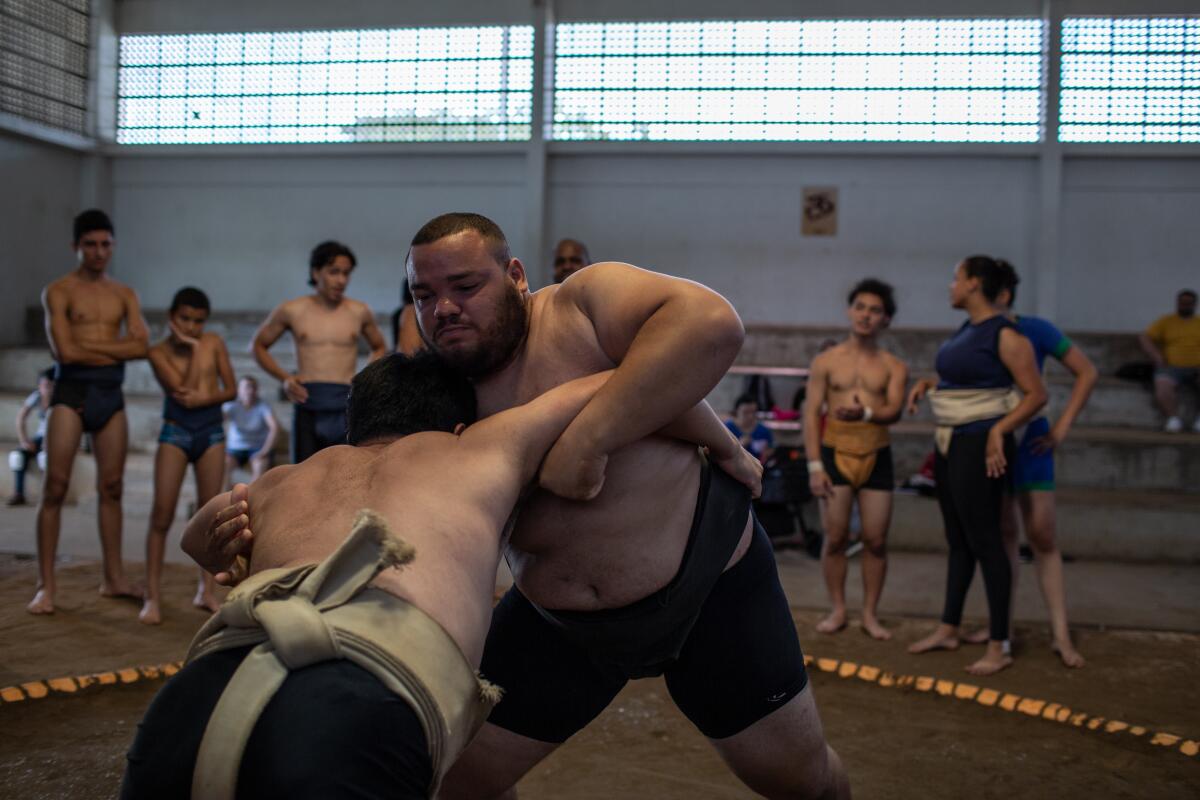
The second bout is not as quick. Junior grapples with the top of his opponent’s mawashi before getting a grip on it. His competitor already has a hold of him and is pushing hard, but Junior doesn’t move. With his hands firmly on the mawashi, he lifts his opponent slightly off the ground, carries him a few steps and sets him down with his foot just outside the ring.
It’s over. Junior steps down from the dohyo to drink water and talk to Shimazaki. As he wipes the sweat from his face with the pink towel, his friends and teammates come over to congratulate him. It takes him a couple of minutes to catch his breath. When his win sinks in, his smile returns to his face.
Now that the competition is over, the rikishis have a barbecue to plan. It wouldn’t be a celebration in Brazil without picanha on the grill, cold beer in hand, and samba and funk on the radio.
Langlois is a special correspondent.
More to Read
Start your day right
Sign up for Essential California for news, features and recommendations from the L.A. Times and beyond in your inbox six days a week.
You may occasionally receive promotional content from the Los Angeles Times.
